originally posted at https://canmom.tumblr.com/post/633971...
hi lesbians, who’s ready to suffer?
In the early 20th century, humans figured out another layer of the structure of the universe. Within a few decades, a vast team of scientists in the USA turned this knowledge into a weapon so devastating it would open the possibility for an entirely new kind of extinction event.
Which they promptly used to erase the populated cores of two cities.
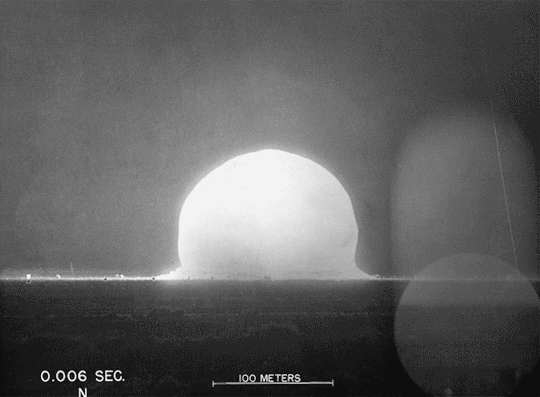
We now live in the era of nuclear bombs.
Certainly, it doesn’t seem quite as pressing now as during the Cold War, where two empires relying on strategies of ‘deterrence’ both raced to make as many of the things as possible, setting them on hair triggers to hit the other guy before the enemy bombs landed. Nowadays, the design of the ‘atomic era’ is seen as kind of kitschy; the post-nuclear apocalypse a kind of cliché. In Fallout 76, you can drop a nuke on an area to get harder enemies and loot in your 50s nuclear playground.
Nukes haven’t gone away, though. And the fear of their use was absolutely real.

So where do these bloody things come from? Why do such materials, so suitable for giant imperial power blocs to turn into weapons, exist? The theological side of that question I leave to take up with your deity of choice, but we can take a brief (brief!) look at the history of figuring out what’s what in nuclear reactions. (Because they never let me write about this on my job, damnit.)
So: up until the early modern period (fuckin early modern period, every time) our theories of ‘what the world is made of’ were pretty much down to philosophical thought experiments. For much of medieval European history, atomism, the idea that the world was made of indivisible (i.e. “atomic”) little bits, was remembered as an unfashionable ancient Greek philosophy rejected by the dominant Aristotleianism, which held (among various other things) roughly that if you cut something again and again, you would pass a natural minimum where it would lose its properties, and end up with one of the fundamental elements sooner or later… but from that point on you could keep dividing forever.
So for centuries upon centuries, the most you might get is some priest looking up Aristotle’s critique of Democritus and being like, hey, maybe that guy was on to something. India had its own atomisms, with both Hindu and Buddhist variants, and the philosophy enjoyed occasional attention in the Islamic world during its ‘golden age’. But it was all thought experiment: nobody thought the hypothetical ‘atoms’ could actually be manipulated; just that, if you follow the chain of ‘whys’ down to the bottom, you’d find little chunky pieces interacting with each other to create sensations of taste and so on.
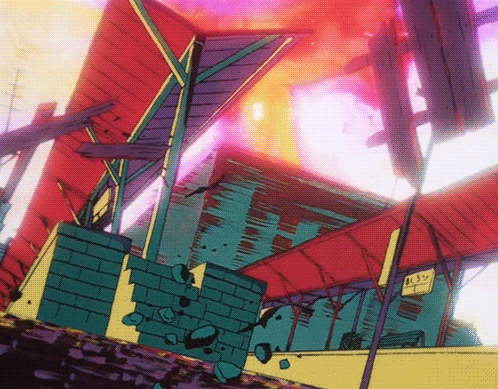
Why relate this history? Because I want to convey something of the suddenness that the following knowledge arrived on the world.
The first inklings of the modern atomism revival came with 17th-century proto-scientific ‘natural philosophy’. Partly this is like, an edgy philosophical avant-garde who were also flirting with ideas like heliocentrism - after all, if Aristotle was wrong about the crystal spheres..? And Democritus’s theories of atomism, where the default state is for motion to continue, better suited their new understanding of falling bodies and such. Because of this, despite certain religious objections, by the end of the 17th century - Newton’s time - atomism was in, philosophically speaking at any rate.
Actual evidence had to wait for the early 19th century. In the 18th, the alchemists-turned-chemists, who were increasingly more interested in practical experiments than the mystical quest for transformation and immortality, were discovering a few interesting facts:
- most chemicals could be isolated down to a few specific, recognisable ‘elements’, suggesting these were the fundamental components of the world
- chemicals tended to react in specific, small-integer ratios of masses: for example, in two different iron oxides, the masses of iron were in a 2:3 ratio

(not this kind of alchemy!)
So with the early 19th century, a dude called Dalton put the pieces together, kinda literally: the chemicals must be made out of little indistinguishable, elemental bits, and the differences between those various salts and such was the amount of each atom. A few years later, Avogadro showed up and said like, hey you can do this thing with gases to work out how heavy they are. Atoms were still being processed in bulk, but we’d glimpsed their properties.
With this insight, it all started falling to place. The new thermodynamics, being rapidly developed to build better steam engines (it’s the industrial revolution, fuckers, hope you’re not too attached to “feudal social relations” or “not being a prole”), found a ready partner in atomic theory, which neatly explained why ideal gases do the various things they do.
Only it turned out that Dalton and Avogadro had missed a trick when they pulled out the name ‘atom’ (understandably!). At the same time as the chemists and thermodynamicists were messing about with gases, electromagnetism was also being discovered, and in 1858-76 (nearly the 20th fuckin century) these exceedingly grumpy looking guys found something weird: stick a charged electrode in a vacuum and it would cast a glow, which would also make a shadow, suggesting a straight-line ray. 15 years later and this beardy one realised these ‘cathode rays’ could be bent with a magnetic field. And so on: with more experiments, evidence mounted: a very light, negatively charged particle.
HMMMMMMMMMMMMMMM.

here’s an old educational film from the 50s promoting nuclear power or some shit. this is not actually what an atom looks like in any way shape or form.
Oh yeah! Maybe these little electron things are in every atom? Atoms may be indivisible by chemical means, perhaps, but are they indivisible altogether? Maybe they’re made of positively and negatively charged bits, mixed together somehow?
We need another piece of the puzzle before we solve this one. Because, naturally, we gotta talk about radiation.
Also in the 18th and 19th centuries (they were busy centuries, lots of colonialism) chemists were in an absolute frenzy of finding new elements. One of these elements was named uranium, distinguished mostly at the time by being very heavy: an atom of uranium is about 20 times as heavy as a carbon atom. It was named for the Greek god Uranus, a choice that seems rather portentous in retrospect.
Cool, who cares right? Well, turns out, says this moustache in 1896, if you put some uranium by a photographic plate it blackens it… just like the cathode rays.
What the shit?

(idk what this cartoon is but it showed up when i searched for Marie Curie)
So, soon it turns out a whole bunch of elements are radioactive. A gas called Radium was, for example, discovered by Marie and Pierre Curie… which killed them. Because oh, yes, it turns out radiation is wildly unhealthy and gives you cancer. Their daughter would go on to be involved in further nuclear research, mind you. So did her kids. Weird family legacy.
You may ask, why is radiation so scary? Because of nuclear binding energy. Nuclear reactions occur on a whole different energy scale than chemical ones. Shoot some particles into a human body with that kind of energy and it’s going to go somewhere, smashing up lots of delicate molecules and causing all kinds of chaos. But we’ll get to that in a second.
Before long, the new discovery of radiation was being used to probe the structure of the atom. The real trick came with Geiger and Marsden shooting alpha particles (one of the newly discovered kinds of radiation) at gold foil, by which they discovered that all the positive charge in the atom seemed to be concentrated into one tiny little clump in the middle, rather than spread about everywhere like the negative charge.
Which was weird. The list of elements suggested that positive charge should come, like the electrons, in fixed-size lumps. Wouldn’t all that positive charge just… explode all over from the mutual repulsion? You could explain that only with some even stronger force holding it together… a force that only acts in the nucleus… a nuclear force if you will. Such a force would imply a great deal of potential energy.
HMMMMMM what could we do with that energy..?
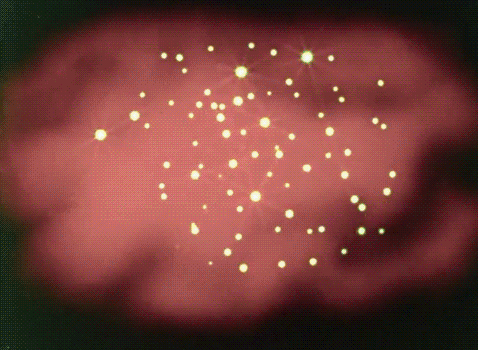
Now, I’ve brushed over a lot in this very rapidfire potted history. This makes it sound like a straight line from alchemy to the discovery of atomic reactions, when it very much wasn’t. Along the way they had to develop, then discard, the entire framework of Newtonianism, which just doesn’t cut it when things are that small. There were plenty of other wrong turns and forgotten experiments and misguided theories, and none of these beardy white chaps (and occasional non-beardy white ladies) was operating in a vacuum, but doing their thing on the backs of a whole like, colonial plunder economy that let them fuck around with weird materials from all over the world instead of like, tilling a field or something, then print their new ideas and have someone read them the next day in a whole different country.
IT’S ALL CONNECTED ok, you can’t escape the socioeconomics bro
But in any case, we’re in the 20th century, we have Maxwell’s electromagnetism on the one hand and the atomic theory of gases on the other, Einstein’s just hit on the whole relativity thing to solve those pernicious problems, quantum mechanics is throwing everyone for a loop, and we can make sense of what happens when we start probing these ludicrously high speeds with really tiny things…

Because what happens when something goes weird in a nucleus? It spits out a little particle or two with absolutely ludicrous amounts of energy. Maybe it’s a little chunk of nucleus (alpha particle), maybe it’s just one of those electrons we were talking about earlier (beta particle), maybe it’s just some very high energy light (gamma ray). The radioactive elements, it turns out, are the ones whose nucleuses aren’t quite put together right… and have a tendency to fall apart suddenly, releasing all that nasty nuclear binding energy, transforming into another element in the process.
(The centuries long quests of the alchemists, to turn base elements into gold, was achieved without much ceremony in a particle accelerator. But really, what the alchemists wanted was not gold itself, but the social power that came from having lots of gold. And opening the door to nuclear energy gave that in abundance.)
To massively simplify things, if it’s bigger than iron, it wants to get smaller. And if it’s smaller than iron, it wants to get bigger. Whether it spontaneously falls apart depends on a variety of things… but the upshot is, big heavy atoms are absolutely juicy with energy.
Now hold on a minute… what happens if we take one of those high energy particles and slam it into one of those unstable radioactive particles?
Enrico Fermi did that in 1934. He thought he’d made some extra-heavy elements… but Ida Noddack said hold on, what if you actually broke those elements into smaller bits? She was right.

Meanwhile, fascism was kicking into gear. Many of these nuclear physicists such as Lise Meitner were Jewish and, as the Nazis unified Germany and Austria, stripped them of citizenship, and got ready to start the war (not to mention the Holocaust), they had to very urgently run to places like the United States. As the factories stamped out new guns and tanks, and Japan started invading China, and Molotov and Ribbentrop drew up their secret protocols, and just about every country was selling shit to Nazi Germany… meanwhile, letters flew about between the atomic scientists, establishing that yes: atoms had split in two, it was different from the known kinds of nuclear reaction, because like, where did all this fucking barium come from suddenly?
Now, splitting one atom releases a bunch of energy (in the form of kinetic energy of the reaction products). But what if the output of one atom splitting could lead to two more? Suddenly you have your hands on the power of exponential growth. Within a fraction of a second, a large fraction of the nigh unimaginable number of nuclei in a block of uranium could be split, resulting in a truly stupendous energy release.
The atomic scientists, expats from now-Nazi Germany, were mostly afraid that the Nazis would figure out this trick. So they reported to the United States government, which was not yet officially at war. “That sounds bad,” said Roosevelt. “Here’s some money. Go and see if that’s a thing.”

It was.
Of course, it wasn’t the Nazis who figured it out. The United States was the one who poured vast amounts of wealth and resources and scientists from across the world into mining, centrifuging and studying uranium, in the (in)famous Manhattan Project.
The consequences of this rapid pace fell in part on the workers on the project, since the risks of radiation were not yet well known and nuclear cores could suddenly become fissile in a burst of intense radiation… and in larger part on the Navajo people, who were used as unwitting experiments in the effects of radiation while their water was massively poisoned by uranium mining. Which like… the mining has stopped, but the uranium didn’t go anywhere, if you’re wondering. As extremely lengthy cleanup efforts continue, many Navajo people have to live on scant, inefficiently distributed supplies of clean water in tanks and bottles, rather than their water table.
Well, somehow, this madcap effort worked: the chain reaction was realised, by intensely compressing a lump of plutonium (which can be manufactured from uranium by nuclear reactions) with conventional explosives. In just three years, from 1942 to 1945, they went from ‘yeah that might be possible?’ to detonating the Trinity “Device”.
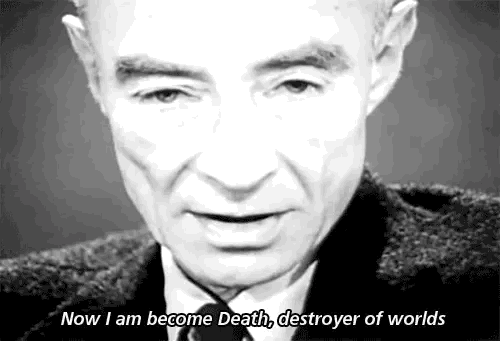
That guy said the line.
A nuclear bomb, roughly speaking, scrambles up the rungs of an ‘energy ladder’: elastic energy triggers a chemical reaction, which creates a fission reaction… and in the later hydrogen bombs, this triggers an even more energetic fusion reaction. All in a fraction of a second.
The result is a vast release of kinetic energy and hyper-intense ionising radiation in a tiny space, which kicks temperatures up orders of magnitude. The release of energy rapidly ionises the air, creating a ball of superheated plasma that vaporises most things in a sphere near the bomb blast itself, and a massive shockwave of spiking pressure which transforms into extreme winds as it spreads out at sonic speeds… not to mention an intensely bright release of ionising radiation which cooks anything exposed to it. In the aftermath, the remnants of the nuke will mix with water and dirt to form nuclear fallout, i.e. radioactive materials which will cause poisoning and cancer for decades, even centuries afterwards.
Before long, the fallout will be wafted up into the air: after the shockwave, the remaining air is hot and low density, causing it to rise, and further winds as the air rushes back in to follow it. The hot air rises until it reaches a matching density level of the atmosphere and blooms out, slowly falling back down as it cools; the result is the characteristic ‘mushroom cloud’ shape. (The same effect comes from any sufficiently big explosion.)
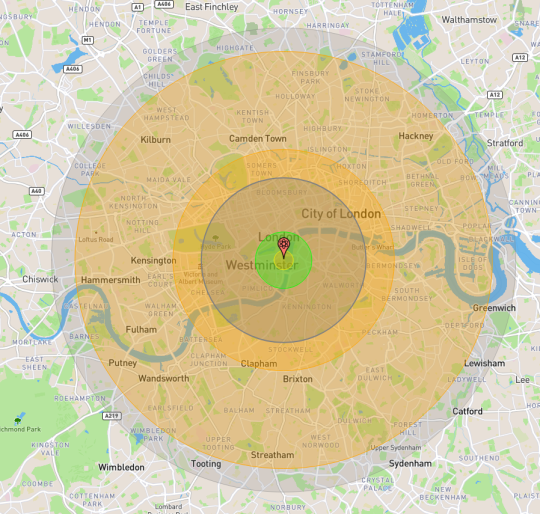
For an interactive sense of what effect this has, check out the Nukemap project. This shows that, if a nuke exploded on Westminster, I’d avoid third degree burns and the most extreme overpressure, but I’d definitely see a lot of damage and have a pretty good chance of first degree burns if caught in the open.
That said, we should keep some proportion. The amount of energy released by a large nuclear bomb (1 megaton or so) is about that of a moderate-sized earthquake, around magnitude 6 if I’m calculating right. Enough to detect on a seismograph; not enough to cause the kind of giant seismic waves that flatten entire regions. What makes it so devastating is that it’s packed into an incredibly tiny space, above ground, instead of ringing around the Earth until its energy can be dissipated over a large area. The precise effects of a nuclear blast depend on all kinds of factors: the height of the explosion, the local geography, the type of buildings.
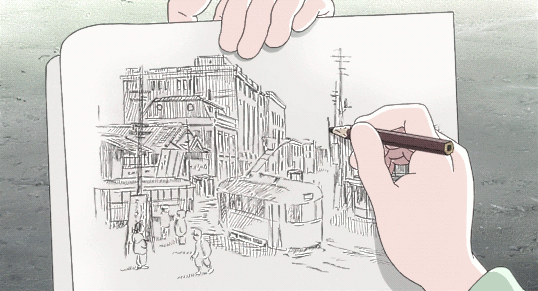
Well, about a month after the first successful detonation of an atomic bomb, the US used it on two Japanese cities: Hiroshima and Nagasaki. The story of Hiroshima is the subject of two of our films this evening.
There’s all sorts of fucked stuff to discuss here. Did the United States really need to augment its already-devastating civilian firebombing campaign with a flashy test of its fancy new toy? Defenders of the bombings (there are such people!) say it forced a faster surrender of the Japanese empire, avoiding a long and bloody land invasion, but as far as I understand the history, Japan was already ready to surrender, just not on terms the US was partial to. And they ended up keeping the Emperor anyway! (Albeit in a largely ceremonial role). The theory that part of the motivation was to send a message to the Soviet Union makes plenty of sense to me, but I would have to defer to people who’ve studied the sources in more depth.
And then, well, there’s targeting. Among the generals and military planners, there was disagreement over whether to target military cities with significant industry, or culturally important cities to burn a few hundred years of history and, they hoped, break the spirit of the Japanese people. One big argument was whether to blow up Kyoto, the historic capital of Japan prior to the Edo period. However, one guy, Henry L Stimson (the Secretary of War), spent his honeymoon there, and petitioned to keep it off the target list. On such grounds, one city was spared, and Hiroshima condemned.

(an anime image of Kyoto - romanticised surely, but well if that one guy hadn’t gotten married then and there, it’d be a crater.)
Very shortly after Hiroshima, Nagasaki - a city whose buildings were mostly made in an older design, of wood - was hit, flattening a large area and causing massive fires.
Of course, it wasn’t long before the USSR got their own hands on the Bomb. Spurred by evidence that the Western powers were suddenly silent on nuclear physics, the USSR had been pursuing their own uranium bomb program during WWII, but without a great deal of success. News of what had happened to Hiroshima and Nagasaki kicked the project into panic mode, assisted by various sympathetic Americans leaking atomic secrets. The USSR detonated their first nuclear bomb in 1949. Within a few years, both powers were racing to add fusion reactions to the mix, and create a much more powerful ‘hydrogen bomb’.
So we enter the period of the Cold War arms race. There are two superpowers; according to their prevailing ideologies, they must each exert as much influence of the world as possible, turning countries towards their own economic and political blocs. This means decades of bloody coups, proxy wars, espionage and political grandstanding; political leaders sought the patronage of the superpowers, which tried their best to subordinate any and all politics into the whole game.
A grand subject for a board game; less grand for someone living in Vietnam.
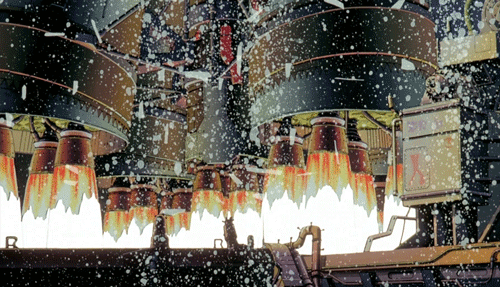
Both parties pursued a policy of ‘deterrence’. A sufficient bombardment of nuclear bombs could be used to completely decimate their enemy’s population and eliminate its economy in a matter of hours; in short, an existential threat for an empire. Both sides believed that, with the nuclear cat being out of the bag, and their enemy surely having no scruples about using it on them (after all, the US had showed just how readily it would throw them out), the only way to avoid this would be fear. Which meant: if a nuclear attack was launched, they would be able to detect it and respond with equivalent force before they landed, so launching nukes would be mutual suicide.
This got transmuted into an arms race. If one country was ahead in nuclear stockpiles, they could inflict more damage in a nuclear exchange, and perhaps take out nuclear bunkers before you have a chance to fire… so you need to build more than whatever you think the other guy had. If the other guy makes rocket missiles capable of flinging bombs across the world, you’d better make sure your own rocketry program is up to snuff.
On that basis, both economic blocs poured vast, vast amounts of money and expertise and effort into making ever more devastating nuclear weapons, further-reaching delivery systems, more efficient systems of hair-trigger detection. There were a lot of close calls when stuff like moonrises, random animals or faulty equipment almost led to an apocalyptic nuclear launch.

Of course, another factor was psychological. As Carol Cohn discussed in her classic article Sex and Death In The Rational World of Defense Intellectuals, a whole industry of carefully sanitised language and thought was developed in the United States to ~reason~ about nuclear weapons, but none of this removed its overtly sexual charge:
I think I had naively imagined myself as a feminist spy in the house of death-that I would need to sneak around and eavesdrop on what men said in unguarded moments, using all my subtlety and cunning to unearth whatever sexual imagery might be underneath how they thought and spoke. I had naively believed that these men, at least in public, would appear to be aware of feminist critiques. If they had not changed their language, I thought that at least at some point in a long talk about “”enetration aids,” someone would suddenly look up, slightly embarrassed to be caught in such blatant confirmation of feminist analyses of What’s Going On Here.
Of course, I was wrong. There was no evidence that any feminist critiques had ever reached the ears, much less the minds, of these men. American military dependence on nuclear weapons was explained as “irresistible, because you get more bang for the buck.” Another lecturer solemnly and scientifically announced “to disarm is to get rid of all your stuff.” (This may, in turn, explain why they see serious talk of nuclear disarmament as perfectly resistable, not to mention foolish. If disarmament is emasculation, how could any real man even consider it?) A professor’s explanation of why the MX missile is to be placed in the silos of the newest Minuteman missiles, instead of replacing the older, less accurate ones, was “because they’re in the nicest hole-you’re not going to take the nicest missile you have and put it in a crummy hole.” Other lectures were filled with discussion of vertical erector launchers, thrust-to-weight ratios, soft lay downs, deep penetration, and the comparative advantages of protracted versus spasm attacks - or what one military adviser to the National Security Council has called “releasing 70 to 80 percent of our megatonnage in one orgasmic whump.” There was serious concern about the need to harden our missiles and the need to “face it, the Russians are a little harder than we are.” Disbelieving glances would occasionally pass between me and my one ally in the summer program, another woman, but no one else seemed to notice
Naturally living under the shadow of some guy in Washington’s orgasmic whump casually ending everything you know and burning untold millions of people to irradiated death exerted a kind of traumatic psychological toll. Which means it had a profound effect on film.
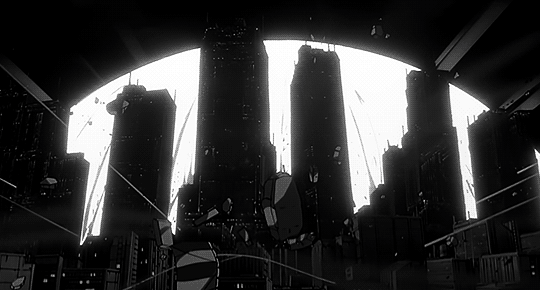
I’m not gonna write like, a whole exegesis on the history of Cold War films here, because there are very many of them. Even like, specific events - the Vietnam War for example.
Japan in particular has a particularly obvious trauma there; you have famous metaphors for atomic bombing in films the kaiju genre, especially Godzilla. In early anime, striking indirect examples would include the disaster at the beginning of Akira, the devastating power of the Castle in the Sky (an imperial relic from nuclear war which must be destroyed lest it be used again), the post-apocalypses of early Miyazaki like Nausicaa and Future Boy Conan, or a great deal of Evangelion. Even in the present anime season, Akudama Drive has a blatant metaphor for the American occupation and atomic bombing radiation in its Kanto-Kansai war and dangerous exclusion zone.
While no state other than Japan has been nuclear bombed in a war, it’s a little more complicated than that to say nobody else has been nuclear bombed, because in many cases, such as the British nuclear tests at Maralinga, which required the forced transfer of the Pitjantjatjara and Yankunytjatjara Aboriginal people living in the area. However, these cases of nuclear trauma haven’t had anything like the same film-industry power to express them, because you know. Ongoing racism.
As for everyone else? We see a little less of this in American animated film - though, that said, a few films like The Iron Giant have very naked ‘please don’t kill us all in a nuclear war’ subtext. There may be examples in French animated film that I’m not aware of.
Tonight, though, we’re focusing on films which deal explicitly with nuclear war, nuclear weapons, and nuclear trauma. Beginning with the most incongruous of the lot: Duck & Cover featuring Bert the Turtle. (Whether there were similar programs in the USSR, I don’t know.)

Duck & Cover is the product of an American informational/propaganda campaign from the 50s, attempting to advise children what to do in the event of an impending nuclear attack. The idea was that some casualties might be spared by hiding behind relatively solid surfaces - and if you were at the outer edges of the blast, you could maybe avoid being lacerated by broken glass or burned by the initial flash. (Naturally it wouldn’t do shit near the centre.)
Of course, much of the seeming intent of the film is to… make the idea of getting nuclear bombed seem like a manageable threat rather than, well, an existential one. Maybe it would have saved lives… but in practice, it put the whole population on notice: we’re going to play the nuclear game now.
It took a while to build up the kind of world-ending nuclear arsenals, during which time, people started to resist the bizarre world order that the physicists had established. In my country, that’s the Campaign for Nuclear Disarmament, which has sustained decades of (largely unsuccessful) protests. However, from my experience, a bizarrely large proportion of people seem to just accept the logic of ‘deterrence’: ‘we’ must have nuclear weapons, because what if..? A politician’s hesitation to plough millions of dollars into replacing old nuclear submarines is seen as a political gaffe, a sign that he’s a crazy leftist. After all, being part of the ‘nuclear club’ is power. You wouldn’t want to lose your nuclear virility, would you?

As with most things in the Cold War, the artists were (rather ineffectually!) standing against it. One example of anti-nuclear war film from the UK is When The Wind Blows by Raymond Briggs; like the BBC’s Threads, though rather less brutal, it watches the survivors of a nuclear war slowly dying of radiation poisoning. In this case, a cute old couple modelled on Briggs’s own grandparents. It began as a children’s book, and later he expanded it into an animated film.
Briggs is one of the few people in this country directing traditional animation not aimed at kids, though he’s mostly known known for his Christmas short The Snowman which gets played every year. But he didn’t just make twee stuff; his comics like Fungus the Bogeyman which is like a depressed, alienated working class Monsters Inc as far as I recall (my dad had it when I was a kid, and like I did not really understand what it was getting at lmao) were kind of a lot more overtly political. Not to mention not-exactly-subtle political satire against Thatcher.
So, When the Wind Blows imagines a naive old British couple (you know, note dynamics of white middleclassness and such here!) who follow all the government’s advice and survive the nuclear exchange, only to slowly die of radiation poisoning as they try to maintain their routines in their damaged house, after the war. I don’t need to spell out the message :p
That’s the hypothetical nuclear war. For the other side of it, we have the 1984 Uzbek adaptation of sci-fi short There Will Come Soft Rains by American author Ray Bradbury, one of the first to predict nuclear annihilation. This is an atmosphere-drenched depiction of an empty, robot-tended house in the wake of a nuclear war.
Following that, we’ll have a look at depictions of the one real nuclear war: two anime films set in Hiroshima which cover the time of the atomic bombing. The first is the 1983 Madhouse film Barefoot Gen, adapted from a long-running manga about a young boy’s life in Hiroshima.

Gen is particularly notable for its horrifyingly vivid scenes of atomic bombing: person after person is melted away, their eyeballs dribbling out as their body is blasted to ash. The explosion itself is an intense splash of paint which fills the entire background. It is probably the most vividly unsettling depiction of what happens when a nuke goes off I’ve ever seen, made worse by the knowledge that yes, this absolutely happened, if not in the exact way depicted.
But Gen isn’t just nuclear death porn, it’s also a historical picture, of what life was like growing up in Hiroshima at a time of intense imperialism and total war. It’s loosely autobiographical, drawing on the experiences of the mangaka Keiji Nakazawa, a Hiroshima survivor. Madhouse released a sequel three years later following Gen’s life after the war, though sadly we do not have time for both films tonight.
Our second film is much more recent, from only last year. In This Corner of the World is a long-term slice through the history of Hiroshima, both before and after the war.
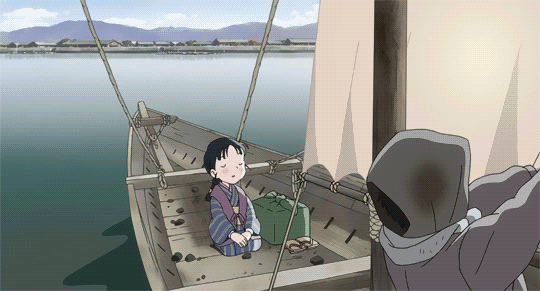
While it doesn’t shy away from the horrors of war, it’s mostly the story of Suzu, a young artist growing up in the city. It deals less with eyeballs melting and more with the traumatic aftermath of the war, as the survivors have to reckon with their loved ones dying of the strange new disease of radiation poisoning - but also the long term story of recovery. It’s a beautiful film, with Suzu’s watercolours seemingly inspiring all sorts of aspects of composition in a soft, muted palette with a lot of gorgeously subtle modern character animation; no surprise it’s been reaping various animation awards. I’ve been looking forward to seeing it for a while.
I know this is a very heavy topic, but also like… I picked these films because they’re sincere and powerful and because like, it does no good to ignore this stuff. Though the Cold War is now three decades over, the United States and Russia still hold vast nuclear stockpiles, many other countries (including, disgustingly, my own) hold some, and naturally none of the leaders of countries in the nuclear club are particularly keen to let go of their ticket (any more than they are keen to let any other country get their hands on the weapons). I would genuinely like to believe that one day, nukes (like nation-states and capitalism for that matter!) will be seen as a sickening historical shame that we’re glad to have escaped alive, and not something like ‘the cause of the great war’. Even if at some point you just have to shunt that knowledge aside to get on with living.
So! It’s almost time for Animation Night 26 to begin, so please head over to twitch.tv/canmom and we’ll be airing the films in like ten-fifteen minutes (just after 7pm UK time)!
Comments